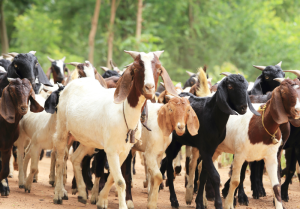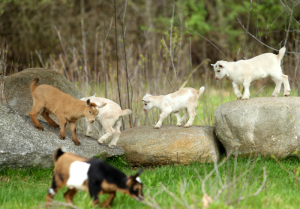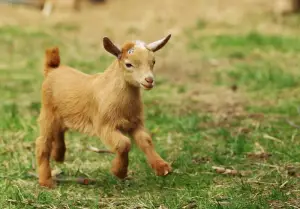How to Tame a Goat
Have you ever considered taming or training your goats? If you’re looking for ways to make your goats easier to handle and more comfortable in their environment, a little training could be exactly what you need.
So, how do you tame a goat? Goats are tamed and trained by utilizing positive reinforcement and by working with them on a consistent basis. It’s easiest to tame a goat when distractions, such as other animals, are limited or removed so that they can better concentrate on the concepts you want to communicate.
Want to learn more about taming and training goats? Read on!
How To Tame A Goat: Challenges with Goat Training
The biggest challenge in training a goat is training yourself first. You must be patient with an animal that has no idea what you’re trying to communicate to it, and you must have patience with yourself while you learn how to teach.
Goats will need to be trained individually. But once they are all trained, it can still be challenging to get a large number to respond positively all at once when they are distracted by each other and all fighting for the first food reward. Goats may need to be separated into smaller groups for things like transfers to another pasture through open space in order to make those events happen with as little stress as possible.
The presence of a predator, even the farm dog, who doesn’t mean any harm, will make it difficult for the goat to focus on understanding you. You’ll need to remove any distractions that you can while still having the goat in a familiar area so that it isn’t also distracted by concern for why it’s in an unfamiliar place.
And sometimes, a goat is simply not in the mood for training. The iron-fist method of making a goat submit to you will not be useful in behavior training. Sometimes you’ll have to accept that it just isn’t the time for training and try again later in the day or tomorrow. Forcing a goat to continue training will usually not have good results for either of you, and it’s best to end training sessions on a positive note.
Useful Things to Train a Goat to Do
- Come when called or follow you
- Step into a trailer or car
- Accept a physical exam
- Wear a halter
- Walk on a lead
Goats can also learn entertaining tricks such as:
- Running an obstacle course
- Shaking hands
- Walking upright on rear legs
- Jumping through hoops
- Walking on a balance beam
How to Earn Your Goat’s Trust for Training And Taming
Goats, like most animals, are highly food-motivated. If being around you means receiving tasty food rewards, a goat will want to be around you. Trust takes time to build, but associating you with positive things like yummy food will go a long way toward building it.
Train Your Goats to Associate Your Presence with Food Rewards
If your goats don’t already come running to the fence when you’re around, start by throwing tasty treats in their direction whenever you walk by. Soon they will make the connection that your presence equals the extra delicious food. Once they start approaching you when you’re around, be sure to reward those who come the closest with an extra piece of food. The others will notice and emulate the first so that they can get extra snacks, too.
Clicker Training Goats 
Once you can easily get the goats’ attention this way, you can start training individually.
You’ll need to separate a goat from the others since they will all be clambering for food, but you don’t want to go too far or to an unfamiliar place. If you can set up a little mini-fenced-in area within the pasture, do so and take one goat in at a time to teach. Allowing others to watch may allow them to learn even faster.
Using a clicker, just like the kind dog trainers use, is an excellent way to not only teach goats new behaviors to do on command but to teach them how to regularly learn new behaviors on command in general.
The point of clicker training goats is to instantly reward the correct behavior. It takes a few seconds to get the treat into the goat’s mouth, and during that time, it’s possible for the goat to miss the precise part of what it just did that it earned the reward for. But once it understands that the click sound, which you can make happen instantly no matter where you are in relation to the goat, the moment it performs the correct behavior, means it will get a treat in a couple of seconds, it will learn the correct behaviors faster.
Press the clicker so that it makes the clicking noise and immediately give the food reward. Do this several times so that the goat is clear on the fact that a click means a treat is coming.
Then ask the goat to “come,” and as soon as it steps toward you, click the clicker and then give the treat. Keep doing this from farther and farther distances to increase the range that the command will work. We start with a small, easy distance simply to make it as easy as possible for the goat to initially grasp the meaning of the command.
By starting as small as possible, like this with other commands, and then increasing the space or intensity with practice, you’ll be able to train your goats to do practically anything you could think of.
Why Goat Training and Taming Is Necessary 
Animal behavior training is the process of identifying natural behaviors animals already do and training them to perform those commands, often in exchange for a reward such as a food treat. It is an incredible process that gets easier with a little practice, and for most animals, it’s an enjoyable experience once they grasp the food reward part.
Almost anything you could need your goat to do, it already naturally does. They naturally walk, jump up, hold still, and do a variety of other things that you can train them to do on command to make your life, as well as their lives, a lot easier. Some simple training could mean no more chasing, wrangling, or carrying heavy, squirmy goats for you. Simply have a supply of treats on hand and make your request of the animals.
Moving Goats from One Pasture to Another
As pastures are eaten down, seasons change, additional animals are brought in, trees fall on fences, etc, there can be a need to move a herd from one pasture to another. If those pastures aren’t connected, you’re in for an interesting time.
You could spend a day attempting to herd goats out of one pasture and however far through open space to the next one, but that’s risky. Some could spook or simply wander out of boredom, and even if you have extra people using pig boards or other barriers to prevent escape between the two pastures, odds are you will encounter some escapees. All it takes is one to rile the rest.
But if goats are trained to come to you or follow you in exchange for a treat, your chances of moving through that space to the next pasture without difficulties or escapees are significantly increased. Because instead of moving the goats against their will, a situation they would be happy to break free of, you’re inviting them to enjoy a treat if they just take a little walk with you. They will want to take you up on the offer. Usually, the excitement of tasty food is more interesting than distractions out in the open.
Transporting Goats to 4H Events or the Vet
Have you ever tried to get a goat to walk into a trailer? The metal floor sounds funny when they step on it. It doesn’t look or smell like regular ground, and if they’ve been in one before, it was probably in another stressful situation. This makes them feel uncomfortable and stressed and more likely to be difficult to manage.
Imagine teaching a goat to walk into a trailer in exchange for a tasty snack and never having to haul it by the halter or heave it up into the trailer and try to block its escape ever again. Imagine having a whole herd simply walk into the trailer and expectantly await their food reward without pitching any fits. Wouldn’t that be a nice change?
For goats getting a ride in your car if a trailer isn’t available, imagine not having to listen to the stressed vocal calls the whole way. Wouldn’t it be nice if a goat simply laid down and relaxed until you reached the destination rather than nervously jumping all over everything?
Goats can be trained not to fear car rides, just like dogs can.
Subjecting Goats to Vet Exams and Necessary Medical Care
Goats are prey animals, and they so don’t appreciate being touched by strangers or even being around strangers at all. They prefer to stay away from unfamiliar people and animals so that they can be sure of their safety.
But sometimes, a vet needs to do an exam to ensure that the animal is healthy or to inspect an injury. The goat will need to sit still for the exam. That could be an even greater challenge if there is a painful wound that needs to be examined. But a lot of the stress can be taken out of the situation both for you, your goat, and the vet staff if you’ve done a little training and can distract the goat with food rewards for tolerating the vet.
This is common practice in zoos for exotic and dangerous animals. Giant tortoises are trained to extend their necks so that a vet can draw blood from the jugular vein to check the animal’s organ functions. Tigers and Lions are trained to stick their paws through a safety barrier so that they can have their claws trimmed while the vet staff remains safely on the other side of the barrier. Alligators are trained to enter a small room off of their enclosure so that zoo staff can safely enter their enclosure and clean it.
All of these things are natural behaviors that the animals were trained to do on command and in exchange for a food reward. You can accomplish the same with your goats!
You can learn more about owning and caring for goats and other homestead animals in my latest articles here!

